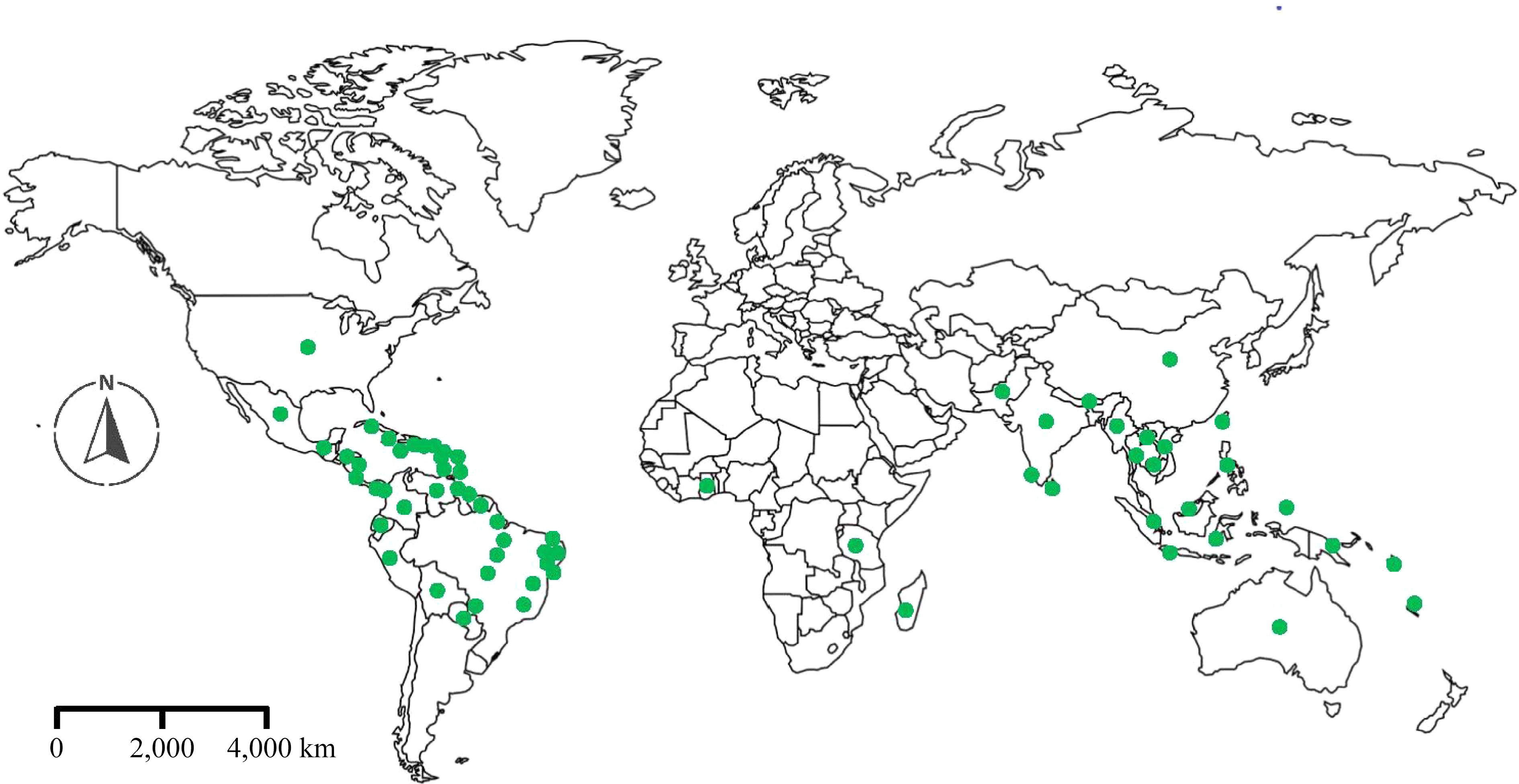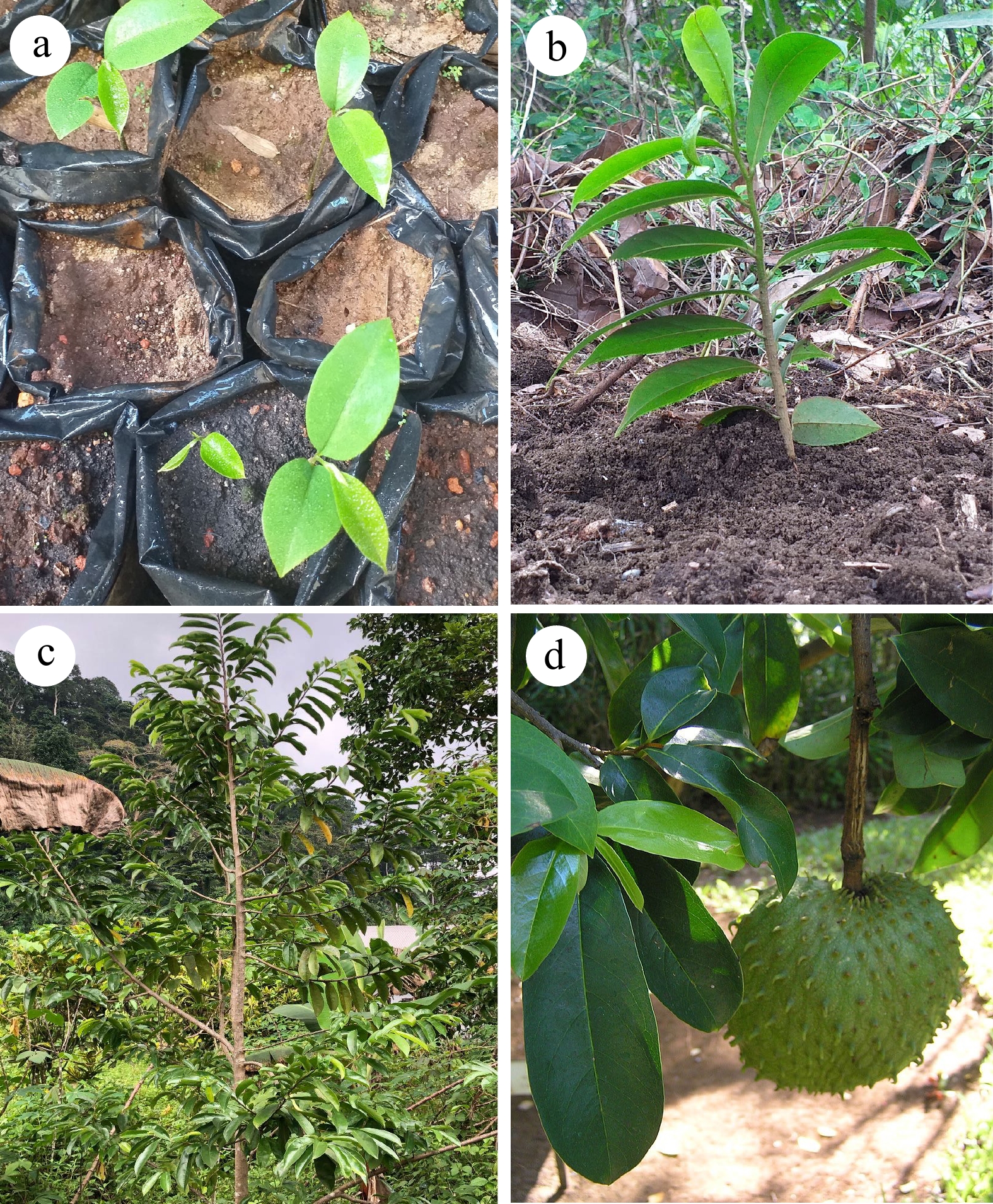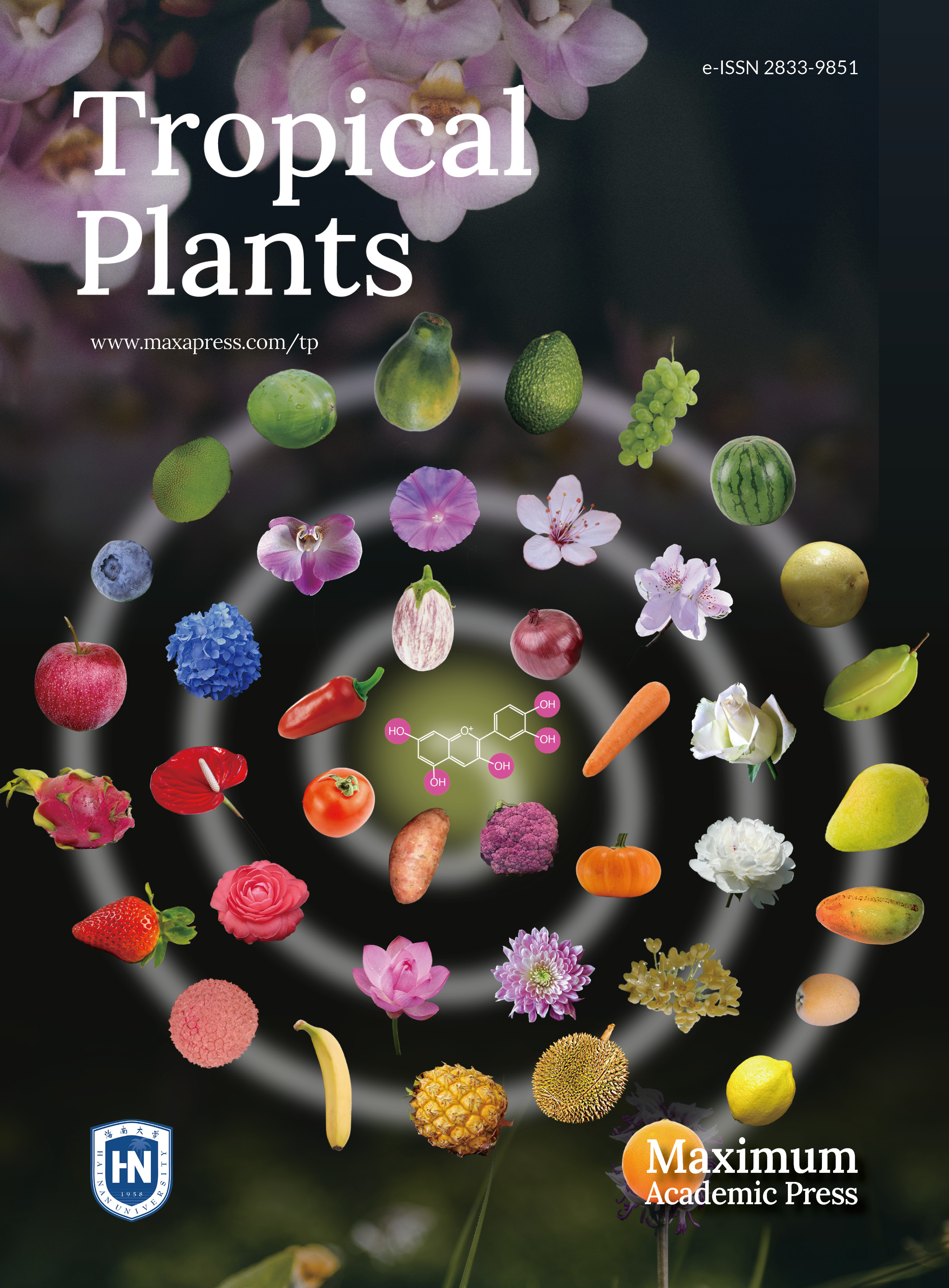-
Achieving food security, improving nutrition, and stopping hunger are at the center of sustainable development goals. The continuous rise in global food prices has raised concerns about how to feed the hungry world. With a current world population of more than 7.2 billion, about 800 million people are chronically undernourished; more than 160 million below the age of 5 years are estimated to be stunted while about 2 billion lack the essential micronutrients they need to maintain a healthy life[1]. Given that most staple crops are facing challenges likely to exacerbate in the future, especially amid climatic variability/change and accelerated soil fertility decline, there is a potential for underutilized crops to improve food security[2]. These underutilized or neglected crops have the potential to play a role in food security achievement by improving the subsistence and income of most resource-poor people in developing countries. Additional benefits include the contribution to food quality and preservation or promotion of cultural and dietary diversity while reducing the risk of over-reliance on a very limited number of major crops. Additionally, agricultural production diversification reduces the impacts of climate change and soil degradation[2]. One such neglected fruit species with known potential for ensuring global food security is the soursop[3−5].
Soursop (Annona muricata L.), also commonly known as 'corrosol' (in French-speaking areas of the West Indies, Africa, and Southeast Asia), 'guanabana' (in most Spanish-speaking countries), or 'graviola' (Brazil), is a tropical evergreen perennial tree species of the Annonaceae family. It originates from the lowland regions of Central and South America (Fig. 1)[6−8]. Most of the important Annona species such as A. cherimola Mill. (cherimoya), A. reticulate L. (custard apple) and A. squamosa L. (sugar apple), originated from South America while A. senegalensis (wild soursop) originated from eastern Africa[7]. In the genus Annona, commonly known as the custard-apple genus, there are about 125 species distributed within and beyond the natural range of tropical America and Africa[9]. Of the 119 species described in the genus Annona, 109 are native to tropical America and only 10 to tropical Africa[10]. Annona muricata is the one that dominates in tropical environments, the largest fruited, and the most suitable for preserving and processing. Morphologically, the soursop tree is small and slender with dark green leaves, grows to a height of about 4−9 m when mature, and produces large green fruits of different shapes (round, ovoid, conical, heart-shaped, and curved) which can weigh up to 7 kg with a length of up to 20 cm (Fig. 2a−d). The seeds are light to dark brown ranging from 13−17 mm long. The soursop bears fruits all year round compared to most Annona species, and so is readily available throughout the year for consumption. Details on the history, botany, horticulture, and other uses of soursop has been reported extensively by Leal & Paull[11].

Figure 1.
Worldwide distribution of A. muricata. Source: adapted from Datiles & Acevedo-Rodriguez[12].

Figure 2.
(a) One-month old soursop seedlings, (b) 6-month old seedlings transplanted on a Eutric Silandic Andosol (Loamic) in a humid tropical forest environment with mean annual rainfall of about 3,100 mm, mean annual temperature of 25.2 °C, and mean annual relative humidity of > 85%, (c) 28-month old soursop tree and (d) a mature soursop fruit.
The genetic resources and plant diversity of Annonas are being wiped out due to modern ways of agriculture and land use changes[13], making genetic resources of edible Annonas to be exclusively present in situ i.e. on the farm, in home gardens or orchards and/or in natural populations[13,14]. With the aforementioned potential of A. muricata and considering the fact that it is still at an incipient stage of domestication, there is an urgent need to modernize and intensify its cultivation in order to improve food security and environmental conservation (agroforestry). Additionally, A. muricata has been identified as a potential rootstock to other commercial Annona species due to its relative tolerance to flooding conditions[15]. Therefore, sustainable plantation management techniques and agronomic practices are vital tools to favor crop growth and optimal production, under suitable/optimal environmental conditions. One of the environmental components that deserves particular attention vis-à-vis management for optimal crop production is the soil. A paucity of information exists on the pedological requirements of A. muricata. Based on a synthesis of published works on the environmental factors influencing soursop growth, the main objective of this work is to identify and establish baseline climatic and soil conditions most suitable for its growth. This information will be helpful in narrowing the knowledge gap for plantation intensification where farm inputs (such as chemical fertilizers and pesticides) and irrigation programs are indispensable for optimizing yields.
-
Annona muricata has recently gained much attention due to its potential uses in the food processing industry. The seeds of A. muricata are rich in oil content and thus could be potentially exploited in oil industries[13]. The pulp is rich in vitamins (ascorbic acid, thiamine, riboflavin, B12, B5,), amino acids (tryptophane, methionine, lysine), minerals (Ca, Mg, K, Na, P, Fe), proteins, lipids, carbohydrates, fiber, energy (calories), ash, flavanoids, tannins, and saponins[7,8,16,17]. Due to its very pleasant aroma and juicy flesh[16,18], soursop is used in industry for the production of soursop juice, punch, ice cream, candies, nectars, yogurts, syrups, and for the preparation of beverages.
In terms of medicinal potentials, plant parts of A. muricata have been shown to have antidiabetic effects[19], antihemolytic effects[20], antiproliferative and anticancer effects[21−25] antioxidant effects[20,23,26−28], anti-inflammatory effects[23,24,28], antibacterial effects[23,27,29,30], molluscidal[31], insecticidal[32] and antiviral effects[20]. Extensive reviews on the traditional/medicinal use and biological activities of A. muricata have been made[33−37].
In tropical agroforestry systems, soursop has the potential to serve as a shade tree and windbreak[38].
Moreover, A. muricata has been shown to possess interesting photocatalytic properties[39], compared to the commercially available chemically derived zinc oxide nanoparticles. The nutritional, medicinal, and ecological benefits are important factors driving interest in soursop production.
-
In the literature, very little has been reported on soursop yield data. In general, soursop yields depend and vary greatly with planting density and field management[8]. Planting densities generally vary from about 2.4 m × 2.4 m to 6 m × 7.5 m, with an average planting density of about 250 trees per ha. Early studies conducted in Puerto Rico reported that acceptable soursop yields ranged from 6.25−10 t ha−1 in well-managed orchards[40]. In Hawaii, optimal soursop yields have been estimated at 18 t ha−1[8] while in Mexico, average yields stand at 8.5 t ha−1[41]. In most cases, it has been observed that proper fertilization generally increases soursop yields, especially with the application of N-P-K fertilizers. Another factor that conditions soursop yield is seedling quality, wherein low-quality seedlings generally produce a smaller number of fruits per tree. In Venezuela, soursop yields ranging between 2.0−2.5 t ha−1 (with an average of 10−15 kg fruits per tree per year) have been reported[42] meanwhile Araque[43] reported yields of 80 kg fruits per tree in an experimental orchard, which is equivalent to about 13 t ha−1. Other factors that influence soursop yields include pests and diseases, the growing environment (climate, altitude, and soil), and orchard management (fertilization, irrigation, planting density, propagation method, size of planting hole, mulching, etc.).
-
It is worth recalling that the principal purpose of agricultural land suitability evaluation is to predict the potential and limitation of the land for the production of a specific crop. Such results can then be used to guide the possibilities for intensification, large-scale production, and commercialization. Studies on land suitability evaluation for soursop are very scanty. This is in part because very little attention has been focused on the crop, and also because there is limited data on its pedological requirements. Where attempts have been made, growth requirement data (climate and soil requirement data) used for land suitability evaluation are mostly based on expert knowledge and data reported in the literature. This is the case, for example, of studies conducted on A. cherimola in southern Ecuador[44]. Similarly, information from the available literature and particular case studies have been synthesized to establish baseline pedological requirements for A. muricata.
Climatic requirements of A. muricata
-
Climatic variables, notably rainfall, temperature, atmospheric humidity, and sunshine greatly determine plant growth. Even though A. muricata is widely distributed in tropical and sub-tropical environments, specific climatic conditions determine its optimum growth and yield potential. In general, a warm and humid tropical climate is most suitable for the production of A. muricata[45]. According to Nakasonne & Paull[46], the optimum geographical range of the species is between latitudes 27° N and 22.5° S of the equator. Although A. muricata can be found in areas with altitudes ranging from 0−2,000 m a.s.l., the most suitable altitudinal range for optimum growth is between 240−300 m a.s.l.[16,25]. However, it has been reported that some high-producing orchards of A. muricata exist at altitudes of about 1,100 m a.s.l.[47]. Given that altitude correlates with temperature, A. muricata is very sensitive to temperature changes. Although A. muricata can grow within a temperature range of 21−30 °C[25], optimal growth and yield is achieved at temperatures ranging between 21−26 °C[8]. Temperatures below 12 °C generally cause considerable constraints in growth, and under conditions of frost (near freezing point), the plants do not survive[47,48]. It has also been reported that the effect of very low atmospheric temperature (< 0 °C) was more severe in A. muricata than other Annona species (sugar apple, pond apple, atemoya), given that juvenile plants of A. muricata were killed at this temperature[48]. In general, temperature alongside air humidity is a determining factor for the successful pollination of A. muricata. High temperatures above 26 °C (especially around 30 °C) and low relative humidity (30%) will cause pollination problems, even when hand pollination is used. On the other hand, successful pollination is achieved at temperatures around 25 °C and high relative humidity (around 80%)[8,49]. When temperatures are very low (close to freezing point), temporary defoliation and fruit failure occur. A. muricata grows well under conditions of high sunshine intensity and will generally not grow well under heavy shades. Although sunshine intensity is high in semi-arid environments, low rainfall is a limiting factor. However, fruits can be successfully obtained in semi-arid environments if irrigation is carried out[47]. A. muricata is susceptible to damage by strong winds since the tree has a soft wood and a relatively shallow root system. Strong winds also cause significant loss of flower during flowering – however, the flowers could be valorized as a potent source of natural antioxidants[26]. In environments witnessing strong winds, fruit productivity is improved by the installation of windbreaks. Mean annual rainfall suitable for its growth ranges from 1,000 to 2,500 mm while environments with a mean annual rainfall < 1000 mm are unfavorable[7,8]. In Sri Lanka, A. muricata is dominant in environments with annual rainfall between 1,900 to > 2,500 mm[3]. Although A. muricata has been reported to be relatively tolerant to flooding/water-logged conditions compared to other Annona species[50,51], heavy rainfall during peak flowering periods significantly reduces the efficiency of pollination[46]. In addition, water-logging in lowland environments significantly affects shoot growth, root morphology, and photosynthetic activity of seedlings[51], and is a major contributing factor to floral abscission and diseases such as root rot[46].
Soil temperature and moisture regimes
-
Soil moisture and temperature have a significant effect on the growth and development of plants through their influence on physiological processes. Based on the aforementioned climatic requirements (air temperature and moisture) of A. muricata, it appears that the species will perform well under particular soil moisture and temperature regimes. Regarding soil moisture, A. muricata will be most suitable under a udic soil moisture regime, where the soil moisture control section is not dry in any part for as long as 90 cumulative days in normal years. This regime type is common to the soils of humid climates that have a well-distributed rainfall. The high suitability of soils with udic moisture regime for the growth of A. muricata is supported by studies indicating that A. muricata cannot be raised under conditions of water stress, given that more frequent watering has been reported to significantly enhance germination and seedling growth compared to low-watering frequency[52]. For example, in a semiarid environment in Brazil, Cavalcante et al.[53] observed that a combination of irrigation and mulching produced the highest yields of soursop on a Quartzipsamment. Soils with a perudic moisture regime would be moderately suitable for growth of A. muricata. Soils with a perudic moisture regime occur in climates where precipitation exceeds evapotranspiration in all months of normal years[54]. Even though it is reported that A. muricata is flood-tolerant[55], drainage systems such as drainage canals and dykes should be installed in environments with water-logging problems to maximize growth and yield. Given that water-logging conditions significantly affect the growth of A. muricata seedlings[46,51], aquic and peraquic soil moisture regimes would be marginally suitable for the growth of A. muricata. An aquic moisture regime is a reducing condition in soil that is virtually free of dissolved oxygen due to saturation by water. Under such conditions, groundwater is always very close to the surface. In the other extreme, very dry soils with an aridic or ustic soil moisture regime pose severe constraints to the growth of A. muricata.
Studies have shown that A. muricata and other Annona species are significantly influenced by soil temperature[56,57], wherein suboptimal or supraoptimal temperatures cause a reduction in both root dry matter and whole plant dry matter accumulation. However, studies have shown that the impact of extreme soil temperatures (suboptimal or supraoptimal) on growth depends on the Annona species. In the case of A. muricata, high soil temperatures ranging between 25–35 °C are most favourable for its growth[56]. On the other hand, higher dry matter accumulation at a temperature of 15 °C for most cherimoya cultivars have been reported[57]. A. muricata like most other Annona species and tropical crops are susceptible to low soil temperatures. Studies have shown that both the fresh and dry weights of roots, stems, and leaves of A. muricata decreased with a decrease in soil temperature, following an almost linear relationship, and established that soil temperatures below 10 °C were detrimental to A. muricata[56].
Based on the aforementioned, soils with a hyperthermic and isohyperthermic temperature regime would be most suitable for the growth of A. muricata where the mean annual soil temperature is greater than 22 °C. Soils with a thermic/isothermic temperature regime (15 to < 22 °C) would be moderately suitable while those with a mesic/isomesic regime (8 to < 15 °C) would be marginally suitable. Soils with a frigid/isofrigid temperature regime (0 to < 8 °C) would be severely limiting. Climatic characteristics influencing A. muricata growth are shown in Table 1.
Table 1. Climatic characteristics influencing the growth of A. muricata.
Climatic characteristic Suitability class Optimal Moderate Marginal Mean annual temperature (°C) 22−25 18−21 < 12, > 26 Mean annual rainfall (mm) 2,000−2,500 1,000−1,500 < 1,000 Relative humidity (%) 70−80 50−60 < 50 Altitude (m a.s.l.) 200−300 300−1,000 < 200; > 1,000 Soil temperature (°C) 25 - 35 10−25 < 10 Soil moisture regime Udic Perudic Aquic, Peraquic, Aridic, Ustic Soil temperature
regime (50 cm soil depth from surface)Hyperthermic/
IsohyperthermicThermic/
IsothermicMesic/Isomesic Definitions of soil temperature and moisture regimes are based on Soil Survey Staff[54]. Soil reaction (pH), Al saturation, and base saturation
-
Soil pH is a key variable affecting plant development and growth due to its influence on numerous soil properties and processes. Many studies have reported that soursop tolerates a wide range of soil pH conditions, ranging from acidic through neutral to basic. This observation has been supported by studies reporting no significant differences in growth parameters of soursop seedlings grown in nutrient solutions with pH ranging from 3−8[58,59]. However, the optimum pH for the growth of soursop has been reported to range between 5.0−6.5[8], 5.5−6.5[60], 6.0−6.5[47], and 6.0−7.5[61]. It, therefore, appears that soursop prefers slightly acidic to neutral soil pH for optimal growth while acidic soil conditions (pH < 5.0) would be moderately or marginally suitable. From the aforementioned analysis, soils with a pH range between 5.5−6.5 are optimally suitable for soursop growth; those with a pH range between 5.0−5.5 is moderately suitable, and very acidic soils with pH values < 5.0 are marginally suitable.
Closely linked to soil pH is Al saturation, which is the relative concentration of exchangeable Al concerning the soil cation exchange capacity. Al saturation serves as an important index of Al toxicity and lime requirements for acidic soils.
According to Pinto et al.[62], acidic soils with pH < 5.5 should be limed to bring the pH to about 6.0−6.5, and at the same time achieve a base saturation of about 60%−70%. Base saturation represents the percentage of the cation exchange capacity occupied by exchangeable bases (Ca2+, Mg2+, K+, Na+) and generally increases with an increase in soil pH. Thus, soils with a high base saturation (> 60%) are highly suitable for soursop growth[62] since they contain optimal quantities of plant nutrients such as Ca2+, Mg2+, and K+ while soils with a low base saturation (< 60%) are moderately suitable.
Acidic soils with a pH < 5.5 contain soluble Al and high Al saturation (> 20%) which is very detrimental to plant roots[63]. The excess Al in acidic soils affects crop growth by inhibiting root growth and rendering the plant susceptible to drought stress.
Additionally, acidic soils with an Al saturation > 20% and/or exchangeable Ca2+ concentration < 0.5 cmol(+)/kg require liming to create a conducive pH environment for soursop growth[63], given that soursop trees do not fruit well when planted on soils with very high Al saturation[64]. Therefore, soils with an Al saturation < 20% are optimally suitable for soursop growth while those with an Al saturation > 20% are moderately suitable.
Soil texture and drainage conditions
-
Soil texture affects plant growth either directly by influencing root penetration and development or indirectly by influencing soil water movement, nutrient retention and supply, and organic matter retention and stabilization. Soil drainage influences soil water availability, air movement, and oxidation/reduction processes, all of which affect plant growth. Even though it is reported that soursop can grow in a wide variety of soils, and can tolerate a wide range of soil textural classes[8], studies have shown that its growth can be significantly influenced by soil physical characteristics such as soil depth and aeration[61,65,66] and soil texture[7]. The most suitable texture for the growth of soursop has been reported to be a light or sandy texture, which promotes the growth of the taproot[7]. Also, deep soils (> 200 cm) with good aeration are conducive, where the taproot can grow up to a length of about 180 cm[66]. Organic matter-rich soils with good drainage and aeration have also been reported to promote the growth of soursop[61]. In general, well-drained and aerated soils reduce the incidence and impacts of root diseases[46, 65]. Soils dominated by a heavy clay texture alongside high relative humidity are a major cause of root diseases of A. muricata[7] since a clayey texture hinders the free circulation of air within the soil profile. Summarily, light or sandy textures such as loam, sandy loam, loamy sand, and sandy clay loam constitute optimal textural classes for soursop growth. Moderately suitable textural classes include clay loam, sandy clay, silty clay, silty clay loam, and silt loam. Marginally suitable textural classes include clay and heavy clay.
Soil organic matter
-
Soil organic matter has significant influence on the physical, chemical and biological properties of soil, thereby affecting nutrient uptake and plant growth. Even though Annona species have been reported to tolerate soils with relatively low fertility status[46], fertile soils rich in organic matter generally favor vigorous growth of A. muricata[61]. This is because organic matter addition improves soil physical properties such as water infiltration, moisture retention, porosity, and bulk density, as well as chemical properties such as nutrient content, nutrient retention, pH, and cation exchange capacity[67−69]. This is even more so at the seedling stage of the plant, where the type of substrate and organic matter type greatly influence their survival and growth. In mature plants (aged between 3 and 6 years), soil organic matter determines the quantity of nitrogen fertilizers to be applied, with the amount of N increasing with tree age and organic matter content[70]. Optimal organic matter content of 6.2% and nitrogen content of 0.25% have been reported in Mexico[71]. Thus, soils with organic matter content > 6% are optimal for soursop growth given that at these levels, nitrogen also becomes sufficiently available for proper development and growth. On the other hand, soils with organic matter content < 6% would be moderately suitable. Given that seedling quality of A. muricata determines the overall growth and fruit quality, studies investigating the most conducive substrates for seedling growth, with specific proportions of organic matter, usually in the form of compost, animal manure, powdered plant materials, and charred plant materials, with/without soil have been conducted. Examples of some substrates influencing the growth of A. muricata seedlings are shown in Table 2.
Table 2. Some substrate combinations influencing seedling growth of A. muricata.
Substrate Effect on
seedling growthRef. 50% soil + 25% humus + 25% carbonized rice husk + [72] Soil + vermicompost + mineral fertilizer + [73] Soil + humus + dried coconut shell powder + [74] 25% cattle manure + 75% vermiculite + [67,68] 50% cattle manure + 50% vermiculite + [67,68] 50% vermiculite + 50% carbonized rice husk + [75] 50% vermiculite + 50% earthworm humus + [75] 42%−50% soil + 42%−50% cured bovine manure + 0.04%−0.07% lime + 0.05%−0.08% single superphosphate + [76] 20% soil + 40% cattle manure + 20% sand + 20% vermiculite + [77] Soil + AMF + 10% vermicompost + [78] Soil + AMF + cocoa shell compost + [79] Soil + AMF +10 t ha−1 rice husk biochar + [80] 77% topsoil + 23% saw dust + [81] 50% topsoil + 50% sawdust + [82] 33.3% garden soil + 66.77% fine river sand + [83] 82% soil + 15% sand + 3% bovine manure + [69] 50% soil + 25% coconut shell powder + 25% carbonized rice husk − [72] Soil + green coconut husk powder − [74] 25% earthworm humus + 75% cassava branches − [68] 50% earthworm humus + 50% cassava branches − [68] 25% bovine manure + 75% cassava branches − [68] +: positive effect on seedling growth. −: negative effect on seedling growth. AMF: Arbuscular mycorrhizal fungi. Substrates composed mainly of soil, minerals (mineral fertilizers and vermiculite), and animal manure (cattle and bovine manure) combined, are suitable for seedling growth and development (Table 2). On the other hand, soilless substrates such as a combination of earthworm humus and cassava branches, in varying proportions, are not suitable. Green coconut husk powder also hinders seedling growth, even though mixed with soil[74]. These substrates influence seedling growth based on their physical and chemical characteristics such as pH, water holding capacity, organic matter content, bulk density, particle size distribution, porosity, and contents of macro- and micro-nutrients supplied by the organic substrates. Therefore, substrate selection for seedling production should be a major factor to consider in the sustainable production of A. muricata. A summary of soil requirements for soursop is shown in Table 3.
Table 3. Soil characteristics, limits and degree of suitability for A. muricata.
Soil characteristics Suitability class Optimal Moderate Marginal Physical characteristics Textural class# Loam,
sandy loam,
loamy sand,
sandy clay loamClay loam, sandy clay, silty clay,
silty clay loam,
silt loamHeavy clay, clay Depth (cm) > 180 cm < 180 cm −
Chemical characteristicsSoil pH 5.5−6.5 5.0−5.5 < 5.0 Soil organic matter (%) > 6% < 6% − Base saturation (%) > 60% < 60% − Al saturation (%) < 20% > 20% − #: The texture is based on USDA textural triangle[54]. -
Based on the literature synthesized in this work, the recommended edaphic requirements for cultivating A. muricata are presented in Table 4.
Table 4. Recommended edaphic requirements for cultivating A. muricata.
Edaphic characteristics Recommended value Climatic characteristic Mean annual temperature (°C) 22−25 Mean annual rainfall (mm) 2,000−2,500 Relative humidity (%) 70%−80% Altitude (m a.s.l.) 200−300 Soil temperature (°C) 25−35 Soil moisture regime Udic Soil temperature regime
(50 cm soil depth from surface)Hyperthermic/
IsohyperthermicSoil physical characteristics Textural class# Loam, sandy loam,
loamy sand,
sandy clay loamDepth (cm) > 180 cm Soil chemical characteristics Soil pH 5.5−6.5 Soil organic matter (%) > 6% Base saturation (%) > 60% Al saturation (%) < 20% The recommended requirements proposed in Table 4 need to be refined and complemented with data from field trials, especially long-term trials. Field trials are very important in enhancing the understanding of soursop cultivation and soil management practices to be adopted. According to Johnston & Poulton[84], field trials are important because they provide field data on crop and soil properties, especially the properties that affect soil fertility. Additionally, they provide long-term datasets that can be used to develop mathematical models to describe a range of agricultural practices that could be used, for example, to predict the effects of climate change on soil properties and the productive capacity of soils. The pedoclimatic requirements suggested in Table 4 are mostly based on data from tropical and subtropical environments of South America where the crop originates. However, other types of environments such as the Mediterranean, could be promising for the cultivation of A. muricata. This is because some other Annona species, notably Annona cherimola has been reported to be well adapted to the pedoclimatic conditions of the Tyrrhenian coastal areas of Sicily and Calabria (Italy), where there are good climate conditions for the production of other exotic and tropical fruits[85]. The establishment of plantations in coastal environments would require that further studies be conducted to evaluate the effects of other important soil characteristics such as soil salinity and sodicity.
-
Even though soursop is considered to be an underutilized crop, it is of significant importance to many local communities and contributes significantly to the diversification and resilience of agroecosystems. It is a crop of considerable interest for future adaptation of agriculture to climate change. In the literature, A. muricata is reported to tolerate a wide range of soil types in tropical and sub-tropical environments. However, an investigation of the available literature focusing on its growing environment indicates that there exist particular pedo-climatic conditions for optimal growth. These requirements serve as baseline information that should be considered in plantation establishment to achieve optimum yields. Within the context of climate change and climate variability, it is recommended that field trials be conducted in different agro-climatic zones to have better insights into its relative performance under different soil types, management types, and climatic conditions. Additionally, the specific soil nutrient requirements of A. muricata need to be determined to effectively establish fertilizer recommendation programs for optimal growth. In light of climate change, future research should also focus on the development of adapted varieties. In the literature that has been synthesized in this work, available information on soil properties is limited to soil texture, effective soil depth, soil organic matter, soil acidity, base saturation, and aluminum saturation. Further studies should be conducted to assess the influence of other important characteristics such as topography (slope), cation exchange capacity, nutrient ratios, and soil salinity.
-
The authors confirm contribution to the paper as follows: study conception and design: Kome GK; data collection: Kome GK, Enang RK; analysis and interpretation of results: Kome GK, Enang RK, Silatsa FBT, Yerima BPK, Van Ranst E; draft manuscript preparation: Kome GK, Enang RK, Silatsa FBT, Yerima BPK, Van Ranst E. All authors reviewed the results and approved the final version of the manuscript.
-
All data synthesized and analyzed during this review are available within the article.
-
The authors express their immense gratitude to an associate editor and two anonymous reviewers for their invaluable remarks, comments and suggestions, which contributed in strengthening the quality of this paper.
-
The authors declare that they have no conflict of interest.
-
Received 23 December 2023; Accepted 15 May 2024; Published online 8 July 2024
- Copyright: © 2024 by the author(s). Published by Maximum Academic Press on behalf of Hainan University. This article is an open access article distributed under Creative Commons Attribution License (CC BY 4.0), visit https://creativecommons.org/licenses/by/4.0/.
-
About this article
Cite this article
Kome GK, Enang RK, Silatsa FBT, Yerima BPK, Van Ranst E. 2024. Baseline edaphic requirements of soursop (Annona muricata L.). Tropical Plants 3: e022 doi: 10.48130/tp-0024-0023
Baseline edaphic requirements of soursop (Annona muricata L.)
- Received: 23 December 2023
- Revised: 01 May 2024
- Accepted: 15 May 2024
- Published online: 08 July 2024
Abstract: Soursop (Annona muricata L.) is considered to be a neglected or underutilized plant. Recently, the plant has been found to have great medicinal potential and could significantly improve food security due to its high nutritional and calorific value. Soursop is reported to grow extensively in tropical environments. However, there is a lack of information on the most suitable soil conditions for its growth and development. This work aims is to identify and establish edaphic requirements of A. muricata through an extensive bibliographic study to contribute information necessary to improve soil management vis-à-vis optimal production. Optimal climatic conditions are as follows: mean annual temperature (22−25 °C), mean annual rainfall (2,000−2,500 mm), relative humidity (70%−80%), soil temperature at 0−50 cm soil depth (25−35 °C), soil moisture regime (udic), altitude (200–300 m a.s.l.). Highly suitable soil physical characteristics include well-drained and deep (> 180 cm) soils with a light texture (loam, sandy loam, loamy sand, sandy clay loam). As concerns soil chemical characteristics, pH should range between 5.5−6.5, high organic matter content, base saturation > 60%, and Al saturation < 20%. These results could be refined with data from field trials conducted in different environments.
-
Key words:
- Soursop /
- Neglected plants /
- Climatic characteristics /
- Soil characteristics /
- Crop requirements /
- Food security.












